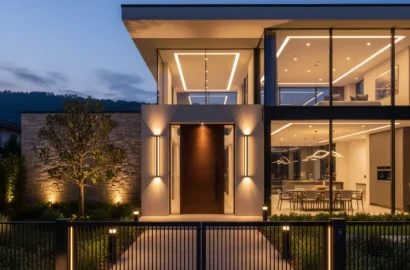Learn how interior design education helps real estate agents and construction professionals serve clients better, expand sources of income, and grow family businesses.
Have you ever walked into a new house and thought something was not right? Perhaps the colors clash, the furniture feels too large, or the outlets are not conveniently located where you need them. With a rise in modern-day clients wanting spaces that work for the way they live, this feeling can impact businesses in more ways than one. And, this is where formal training in interior design saves the day.
Interior Design education can help you avoid mistakes such as placing a grand window that never sees the morning sun or arranging a kitchen that needs one to move constantly between the stove and the fridge. Learning how people really live in their homes is the key to turning a good building into a dream home. It is not about fluffing pillows or picking the perfect paint. It is about understanding your clients, improving your reputation, and winning more work. Understanding design can help you do all of this and more.
Here is a complete list of what we are going to cover in this blog:
- The Interior Design Gap in Real Estate and Construction Services
- Real Benefits of Interior Design Education
- How Interior Design Knowledge Helps Real Estate Agents
- Construction Workers and Contractors: Why Design Education Matters
- Family Business Benefits
- What You’ll Learn in Interior Design Classes
- Getting Started Education Options
The Interior Design Gap in Real Estate and Construction Services
Real estate and construction industries focus on creating buildings, but one thing is often missing or outsourced: interior design. Many professionals in these fields do not study design, creating an obstacle to their ability to serve clients better and shine in a crowded market. Strong structures matter, yet it is the inside of a space that makes it feel like a home or a great office. Interior design turns a plain building into a place people love.
Today’s buyers want more than bedrooms and bathrooms. They want a place that fits how they live, keeps them happy and healthy, and feels truly their own. When they ask for a kitchen island or a flexible room, they are really seeking a home that acts as a personal retreat. Agents and builders who only note a list of features miss the chance to connect deeply with clients and often have to hire experts to help them deliver value.
What Clients Really Want Today
Clients nowadays see rooms on social media and expect to replicate the same in their homes. They want comfortable spaces. When they buy or rent, they want an ideal home that fits their lifestyle. Agents and builders must answer design questions like color choices or furniture fit. Buyers value open layouts, smart storage, central islands, pantries, and laundry rooms. They also need flex rooms for offices or gyms, tech features like smart doorbells, and energy-saving windows. Millennials demand move-in-ready homes with wellness spaces such as home spas or lounges.
The Gap Between Building and Living
Building a house is not the same as living in one. Construction makes walls safe and solid. Living in a home is about how it feels. Interior design bridges this gap. Training in design helps real estate and construction pros create spaces people love.
Contractors know how to build strong walls. Agents know how to set prices. But neither of them would know how a family will use a kitchen or how a sofa would fit. Without design knowledge, outlets end up behind beds, and harsh lights replace cozy lamps. Fixing these mistakes after the walls are finished costs time and money. Having design knowledge as a professional in these fields makes homes work better right from the start.

Real Benefits of Interior Design Education
Formal training in interior design does more than teach style. It gives you a clear process for solving design problems. It turns design from a matter of personal taste into steps you can explain. This process leads to better talks with clients, higher fees, and fewer costly errors. You learn to explain why you made each choice. Clients trust you more and see you as an expert. Read on for some specifics into these benefits.
1. Better Client Relationships
When you understand interior design, you connect better with clients. You can talk about their vision in clear and helpful ways. If they say they want a space to feel cozy but not small, you know how to make that happen with the right colors, lighting, and furniture layout. This makes clients feel understood. They trust you more, and they are more likely to return or refer you to others. In real estate and construction, this kind of trust leads to more projects and long-term success.
2. Higher Project Values
Good design adds real value. Studies show that well-designed homes can sell for more than ten percent higher. Homes that look and feel right also sell faster. For real estate agents, this means higher commissions. For builders and contractors, it means bigger profits and more demand. When you understand design, you can offer more than just construction—you can offer spaces that come with function and aesthetics. This allows you to charge more for your services and stand out in a competitive market.
3. Fewer Design Mistakes
Design mistakes can cost a lot of time and money. Wrong paint colors, poor layouts, or furniture that does not fit are all common issues when design is not considered early. With interior design training, you can spot and fix these problems before they happen. You plan smarter, choose the right materials, and design spaces that actually work. This keeps projects running smoothly, saves time, and keeps clients happy. A smooth project also helps build your reputation for quality and care.
How Interior Design Knowledge Helps Real Estate Agents
For real estate agents, knowledge of interior design is a useful skill. They can do more than show homes. They can help buyers imagine what the home could become, eventually making this their USP in a crowded market.
1. Staging Properties
Home staging is more than tidying up and placing furniture. It is about creating a feeling that draws buyers in. A well-staged home looks bigger, brighter, and more welcoming. With interior design knowledge, agents know how to place furniture, use lighting, and choose colors that make a space feel right. This can help a home sell up to an average of 73 percent faster.
Many agents hire staging companies. But if you understand design, you can do it yourself. This saves money, gives you more control, and adds value for your clients.
2. Helping Buyers See Potential
Many buyers cannot picture how a space could look. Outdated colors or closed-off layouts can turn them away. But a design-aware agent can suggest small changes like opening up a wall, adding natural light, or updating finishes.
This builds trust. Buyers feel guided and supported. They start to imagine their future in that space. You help them move past flaws and see what a property could become. This leads to quicker decisions and more sales.
3. Standing Out from Other Agents
Real estate is competitive. Most agents focus on square footage and price. But when you understand design, you can offer something more. You talk about space flow, function, and how to make a house feel like home.
Clients remember agents who go beyond the basics. They tell friends and family about your services, and your reputation grows. You can even promote yourself as a real estate and design expert, offering help before and after the sale. This kind of service leads to more referrals and a stronger, lasting business.

Construction Workers and Contractors: Why Design Education Matters
For contractors and construction workers, learning design is not about becoming a designer. It is about becoming a better builder. It helps them work well with others, make better decisions at work, and give clients a result they will love. More details in our pointers below:
1. Understanding Client Vision
Clients often struggle to explain what they want. Words like modern or cozy can mean different things to different people. With interior design knowledge, contractors can better understand these ideas. Instead of only following the blueprint, they can see the intent behind it.
A contractor trained in design becomes more than a builder. They can suggest smart changes, spot issues early, and make better on-site decisions. They ask the right questions and help clients make choices that match their lifestyle, leading to smoother projects and stronger client trust.
2. Making Smart Material Choices
Choosing the right materials is about more than price. Some materials look great but wear out quickly. Others are strong but do not match the style of the space. Interior design education teaches how to balance function, cost, and appearance.
Contractors can learn which flooring works best for busy areas, what kind of countertops suit cooking spaces, and which paint finishes are best for different rooms. These smart choices save clients money over time and improve the final result. Clients trust contractors who understand both quality and design.
3. Avoiding Costly Redesigns
Fixing mistakes after construction starts is expensive. Without design knowledge, it is easy to miss things like outlet placement, lighting needs, or space flow. These problems often require time and money to fix later.
Design training helps contractors think ahead. They plan with the final space in mind, making sure everything fits the way clients live. This means fewer delays, fewer changes, and less stress. Clients appreciate the smooth process, and the contractor earns a reputation for getting it right the first time.
Family Business Benefits
For a family-owned business in real estate or construction, learning design is more than a smart choice. It is a strong way to build a lasting future. It helps family members speak the same language, understand the full business, and offer a trusted service that others find hard to match.
1. When Multiple Family Members Work Together
Many real estate and construction companies are run by families. Parents, children, and siblings often work as a team. When one person learns interior design, the entire business gets better.
Each family member can handle different parts of the job. One may focus on building, another on sales, and another on design. This helps the company offer more complete services. Clients prefer working with one team that does it all. It saves them time and makes communication easier. With design knowledge in the mix, the family team becomes more skilled and more trusted.
2. Teaching Kids the Full Picture
If you plan to pass your business to your children, design education gives them a strong start. It helps them understand not just how to build or sell, but also how to create spaces people enjoy.
Families with design education learn to think about the way people live in a space, not just how to build it. They can spot trends and offer ideas that older team members may not see. This kind of training makes them more confident and ready to lead the business one day.
3. Building a Complete Service Business
When a family company offers both design and building, it becomes a one-stop solution for clients. People want one team to handle everything from start to finish.
With design knowledge, your business can offer better planning, better results, and better service. Clients will pay more for a company that takes care of every detail.
This also helps the business stay strong during hard times. If one part of the business slows down, another can grow. Offering the full range of services brings more profit, happier clients, and long-term success.
What You’ll Learn in Interior Design Classes
If you are thinking about studying interior design, you may wonder what you will learn. These courses teach many different skills. They blend creative ideas with practical methods and business know-how. Here is what you can expect to study.
1. Space Planning
You will learn how to arrange rooms for easy use. You study furniture layouts, clearances, and flow, helping create user-friendly and efficient spaces.
2. Color Theory
You will explore the science and psychology of color. You discover how hues affect mood and how to build a harmonious palette. You learn to use color to make a room feel larger, cozier, or more vibrant.
3. Material Selection
You will gain knowledge of fabrics, woods, metals, and finishes. You learn to evaluate durability, upkeep needs, and cost. This lets you recommend materials that fit both budget and lifestyle.
4. Lighting Design
You will study ambient, task, and accent lighting, as well as their effects. You learn where to place fixtures for the best brightness and mood. Good lighting makes any space feel warm and inviting.
4. Furniture Design and Placement
You will learn how to pick pieces that match a room’s style and scale. You also master placement techniques that enhance comfort and flow. This avoids cramped layouts and awkward gaps.
5. Building Codes and Safety
You will become familiar with the rules that keep spaces safe and legal. You learn about fire codes, accessibility standards, and structural requirements. This ensures your designs meet all regulations.
6. Sustainable Design
You will discover how to use eco-friendly materials and methods. You study energy-saving options and green practices, enabling you to create healthier and more earth-friendly spaces.
7. Design Software and Drafting
You will master tools like AutoCAD, SketchUp, and Revit. You’ll also practice hand drafting and digital modeling. These skills let you produce clear plans for clients and builders.
8. Client Communication and Project Management
You will learn to interview clients, present ideas, and manage expectations. You also study budgeting, scheduling, and coordination with vendors. These business skills ensure projects run smoothly and on time.
Getting Started Education Options
Starting to learn interior design is easier than you think. Many options fit the busy lives of real estate and construction professionals. You can choose online certificates, diplomas, or in-person workshops. There is a course for every goal and budget. The table below will help you pick the right one.
|
Pathway |
Best For |
Time Commitment |
Outcome |
Providers |
|---|---|---|---|---|
|
Online Certificate |
Busy professionals who need flexibility and want to build focused skills. |
6-18 months, often self-paced. |
A professional certificate, a portfolio of work, and proficiency in design software. |
AND Academy, NYIAD, Udemy, The Interior Design Institute, Texas State University |
|
In-Person Certificate |
Hands-on learners who want to build a local professional network. |
1-2 years, typically part-time. |
A professional certificate, direct feedback from instructors, and valuable networking opportunities. |
Parsons, Pratt, RISD, NYSID, UCLA Extension |
|
Associate’s Degree |
Individuals looking for a formal degree or career changers seeking a foundation for professional licensure. |
2 years, full-time. |
An Associate of Applied Science (A.A.S.) degree, which can be a step toward taking the NCIDQ licensing exam. |
New York School of Interior Design (NYSID) |
|
Workshops & Short Courses |
Professionals who want to quickly upskill in a single, specific area like home staging, lighting design, or a particular software. |
A few hours to a few days. |
A targeted new skill and, in some cases, Continuing Education Units (CEUs). |
The CE Shop, The Interior Design Institute, and various local design centers |
What AND Academy offers.
AND Academy offers part-time interior design programs for anybody who wants to learn but doesn’t see going to campus as a feasible option. They run live online sessions that fit around your job and other commitments. Their courses teach basics like color, layout, and furniture style. You also work on real home and office projects. Plus, you learn popular design software.
Bonus: The course format lets you keep working in real estate or construction while you pick up useful design skills.
Certificate in Interior Design
This course is perfect for beginners. You join live classes led by professionals. You make simple concept boards and small home layouts. You learn space planning, styling, project steps, and basic 3D rendering. By the end, you have clear projects in your portfolio and the tools you need to start offering design services.
Fee: ₹63,000 + GST (discounted to ₹58,590 + GST)
Duration: 6 Months, 110+ Sessions
Diploma in Interior Design
The Diploma course is taught live by mentors with industry experience. The course covers spatial planning, interior styling, project management, and 3D rendering. You’ll get to work on real projects, such as designing a residential space, in turn building an impactful professional portfolio. By the end of it, you’ll find yourself ready to work with clients or join a design firm.
Fee: ₹1,26,000 + GST (discounted to ₹1,17,180 + GST)
Duration: 1 Year, 230+ Sessions, with Placement Support
Conclusion
Interior design education is a smart choice for agents, builders, and family teams. It helps you create spaces people love, leading to faster sales and higher profits. Many programs fit around your work day and cost less than the value they provide.
Today’s clients want experts who know how people live in their homes. Your competitors might already be adding these skills to their kitty. If you want to stay ahead, now is the time to act.
Next Steps
We hope this article was of help to you. Here are some more resources and steps you can contemplate before arriving at a final decision:
- Watch this session by Snehanshu Mukherjee, Founding Partner at T.E.A.M, and Mansi Almadi, an Interior Designer at Studio Lotus
- Talk to a course advisor to discuss how you can transform your career with one of our courses.
- Check out our Interior Design courses – all courses are taught through live, interactive classes by industry experts.
- Take advantage of our scholarship and funding options to overcome any financial hurdle on the path of your career transformation.
Note: All information and/or data from external sources is believed to be accurate as of the date of publication.









